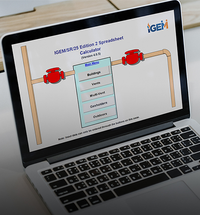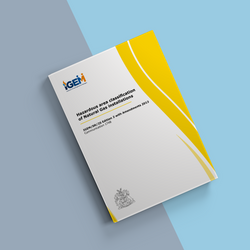
IGEM/SR/25 Edition 2 - Hazardous area classification of natural gas installations

This standard complements BS EN 60079-10-1 by providing detailed requirements for the hazardous area classification of permanent and temporary natural gas installations. It applies to all natural gas installations, although other standards may be more readily applied for installations downsteam of an emergency control valve. In general, it will not be less conservative than these other standards and therefore it may be used for any natural gas installation. It applies to liquid free natural gas within specific property ranges.
This standard applies to any potential release of natural gas except those that may be caused by catastrophic failure such as rupture of a process vessel or pipeline, component failure and similar rare events that are not predictable.
Specifically, it contains details of:
- Legal considerations such as the Health and Safety at Work etc. Act and the Environmental Protection Act
- Classification of hazardous areas in different environments, such as outdoors, within covered pits, within enclosed spaces
- Calculation of ventilation levels and zoning distances.
Introduction
1.1 This Standard supersedes IGE/SR/25 Edition 1, Communication 1665 which is obsolete.
1.2 This Standard has been drafted by a Panel appointed by the Institution of Gas Engineers and Managers’ (IGEM’s) Gas Transmission and Distribution Committee and is published by the authority of IGEM’s Council.
1.3 General guidance on the principles, definitions and explanations of terms relating to hazardous area classification has been set out internationally by the International Electrotechnical Commission (IEC) and, in Europe, by the European Committee for Electrotechnical Standardization (CENELEC), followed nationally by bodies such as, in the United Kingdom (UK), the British Standards Institution (BSI). These bodies state (see BS EN 60079-10-1) that, for detailed recommendations regarding the extent of the hazardous areas in specific industries or applications, reference may be made to the codes relating to those industries or applications.
This Standard provides a procedure for hazardous area classification around installations handling Natural Gas (see Sub-Section 2.2) providing a basis for the correct selection and location of fixed electrical equipment in those areas. In addition, the recommended zoning restrictions are relevant with regard to the introduction and use of any temporary mobile electrical equipment or other potential ignition source.
1.4 This Standard is based on good engineering practice and the use of mathematical models which have been validated by experimental work. This work is detailed in report 9220 (Commissioned by IGEM) and HSE report RR630. The principles have been applied successfully in the UK in recent years.
1.5 Comparison of this Standard with IGE/SR/23 (see Appendix 2) for identical venting arrangements under maximum flow rate conditions may indicate differences in calculated safe dispersion distances.
IGE/SR/23 gives guidance on general vent design and, as such, the process engineer undertaking the design will be expected to take into account all the process variables when designing the vent. These will include a recognition that the IGE/SR/23 design guide is based on steady-state conditions; that a process vent is capable of releasing at any rate up to its maximum and that the safe dispersion distance for certain momentum-driven releases reaches a peak at flow rates below the design maximum. Also, the process engineer will need to determine whether differences in gas composition and temperature are significant and, if so, ascertain the extent of their contribution.
Note: As a result of the research (see clause 1.8) leading to the extensive revision of IGEM/SR/25, IGE/SR/23 will be reviewed.
IGEM/SR/25 takes a pragmatic approach to the determination of safe dispersion distance and presents the results in the form of tables. In so doing, IGEM/SR/25 avoids both the need to consider differences in gas composition and temperature and the need to first determine the flow rate that coincides with the peak distance.
1.6 The dispersion of a Natural Gas release is determined by the interaction of the momentum and buoyancy forces of the release and the atmosphere within which it is dispersing. For an unimpeded jetted release, for example through a vent, the release momentum dominates and the initial dispersion is dominated by the shear between the release and the atmosphere. However, if the release is at a low velocity or is impeded to such an extent that its momentum is
redirected or dissipated, the release buoyancy and atmospheric effects become more important.
There are a number of dimensionless groupings that can be used to estimate which of the factors is likely to be more significant. However, as a rough guide, for all small releases of Natural Gas, the dispersion in the atmosphere will dominate, for example similar to dispersion of smoke from a cigarette. For larger releases, the stage may be reached (especially in low wind speed conditions) when the release buoyancy is significant and the release will lift-off from the ground and disperse like a plume, for example similar to a smoke plume from a large bonfire.
The methodology used in this Standard takes these factors into account, with different models (jet dispersion, atmospheric dispersion and plume dispersion) being employed over a range of wind speeds up to 10 m s-1. The values quoted refer to a worst case value found within this range.
1.7 This Standard enables the user to provide a hazardous area classification for installations that do and do not meet best practice, with regard to design and/or site location. Consequently, requirements are given for:
- ideal and non-ideal venting arrangements
- enclosures that have:
- more than adequate ventilation
- adequate ventilation
- less than adequate ventilation, which embraces poor ventilation.
Primarily, IGEM/SR/25 enables the user to identify certain hazards associated with Natural Gas installations. Legal obligations require operators of such installations to be aware of the hazards and to minimise the risks.
Provision of hazardous area classification and the subsequent compliance is the preferred (and often the only) method of satisfying legal obligations to keep such risks to a minimum (but see Section 3).
1.8 Work carried out by the Health and Safety Laboratory (HSL), has used the concept contained within BS EN 60079-10-1 that small gas releases (even continuous) can give rise to zones of negligible extent, which do not result in a need for any special precautions regarding allowable equipment. This concept did not exist in IGE/SR/25 Edition 1 – any potential release gave rise to a discrete zoned area, resulting in zones even around low pressure pipework in the open air.
Within BS EN 60079–10-1, the concept of a hypothetical volume (Vz) associated with a gas release is discussed, within which the average gas concentration is 50% of the lower flammability limit (LFL). It is related to the gas release rate, the ventilation and the enclosure volume. If Vz is less than 0.1 m3, a zone of negligible extent is deemed to exist. Provided the availability of ventilation is good, the area may be regarded in the same way as non-hazardous. Where availability of ventilation is less than good, or is not present virtually continuously, a discrete (not negligible extent) zoned area will usually result.
Note: Further information about the HSL research work is available in the HSE report RR630.
1.9 This Standard makes use of the terms “must”, “shall” and “should”, when prescribing particular requirements. Notwithstanding Sub-Section 1.12: • the term “must” identifies a requirement by law in United Kingdom (UK) at the time of publication
- the term “shall” prescribes a requirement which, it is intended, will be complied with in full and without deviation
- the term “should” prescribes a requirement which, it is intended, will be complied with unless, after prior consideration, deviation is considered to be acceptable.
Such terms may have different meanings when used in legislation, or Health and Safety Executive (HSE) Approved Codes of Practice (ACoPs) or guidance, and reference needs to be made to such statutory legislation or official guidance for information on legal obligations.
1.10 It is now widely accepted that the majority of accidents in industry generally are in some measure attributable to human as well as technical factors in the sense that actions by people initiated or contributed to the accidents, or people might have acted in a more appropriate manner to avert them.
It is therefore necessary to give proper consideration to the management of these human factors and the control of risk. To assist in this, it is recommended that due regard be paid to HSG48 and HSG65.
1.11 The primary responsibility for compliance with legal duties rests with the employer. The fact that certain employees, for example “responsible engineers”, are allowed to exercise their professional judgement does not allow employers to abrogate their primary responsibilities. Employers must:
• have done everything to ensure, so far as is reasonably practicable, that there are no better protective measures that can be taken other than relying on the exercise of professional judgement by “responsible engineers” • have done everything to ensure, so far as is reasonably practicable that “responsible engineers” have the skills, training, experience and personal qualities necessary for the proper exercise of professional judgement • have systems and procedures in place to ensure that the exercise of professional judgement by “responsible engineers” is subject to appropriate monitoring and review
• not require “responsible engineers” to undertake tasks which would necessitate the exercise of professional judgement that is not within their competence. There should be written procedures defining the extent to which “responsible engineers” can exercise their professional judgement. When “responsible engineers” are asked to undertake tasks which deviate from this they should refer the matter for higher review.
1.12 Notwithstanding Sub-Section 1.9, this Standard does not attempt to make the use of any method or specification obligatory against the judgement of the responsible engineer. Where new and better techniques are developed and proved, they should be adopted without waiting for modification to this Standard. Amendments to this Standard will be issued when necessary, and their publication will be announced in the Journal of IGEM and other publications as appropriate.
1.13 Requests for interpretation of this Standard in relation to matters within its scope, but not precisely covered by the current text, should be addressed in writing to Technical Services, IGEM, IGEM House, 26-28 High Street, Kegworth, Derbyshire, DE74 2DA and will be submitted to the relevant Committee for consideration and advice, but in the context that the final responsibility is that of the engineer concerned. If any advice is given by or on behalf of IGEM, this does not relieve the responsible engineer of any of his or her obligations.
1.14 This Standard was published in October 2010.
Scope
2.1 This Standard complements BS EN 60079-10-1 by providing detailed requirements for the hazardous area classification of permanent and temporary Natural Gas installations. A hazardous area is an area in which explosive gas/air mixtures are, or may be expected to be, in quantities such as to require special precautions for the construction, installation and use of electrical apparatus or other sources of ignition.
Note: Releases of heavier-than-air or neutrally-buoyant gases and vapours are covered by EI IP-MCSP-P15.
2.2 This Standard applies to all Natural Gas (as defined in Sub-Section 2.3) installations. However, for any installation downstream of an emergency control valve (ECV), other Standards may more readily be applied, as follows:
- for primary and secondary meter installations in industrial and commercial premises, where the equipment has been installed in accordance with IGEM/GM/5, IGE/GM/6, IGE/GM/8 or BS 6400 and has been tested to, and complies with IGE/UP/1, IGE/UP/1A, IGE/UP/1B or IGEM/UP/1C (as appropriate), IGEM/GM/7A and IGEM/GM/7B may be applied rather than IGEM/SR/25 but IGEM/SR/25 has to be applied to installations where any one of the following apply:
- ventilation is of the forced type
- maximum operating pressure (MOP) exceeds 75 bar
- creep relief vents terminate within the installation enclosure
- the installation is at a remote, unmanned, site
- it is considered that leaks may go undetected
- unodourised gas is metered
- a competent person considers there to be unusual site circumstances. • for industrial and commercial installations downstream of the primary meter installation, or downstream of the ECV if a meter installation is not installed, where the installation has been installed in accordance with IGEM/UP/2, IGE/UP/3, IGEM/UP/6, IGE/UP/9, IGE/UP/10 or IGE/UP/12 and tested in accordance with IGE/UP/1 or IGE/UP/1A the new Standard, IGEM/UP/16 will apply. However, IGEM/SR/25 may still have to be applied to, for example higher pressures; non-standard designs and hazardous areas created by other energy sources, etc.
In general, IGEM/SR/25 will not be less conservative than these other Standards and, therefore, it may be used for any Natural Gas installation.
Note 1: It is recognised that there are other techniques available to enable the management of risk, for example dilution ventilation.
Note 2: IGEM/GM/7A contains specific procedures relating to electrical connections to gas meters.
Note 3: It would not be normal to apply IGEM/SR/25 to a single domestic gas installation.
2.3 This Standard applies to liquid-free Natural Gas with a combined proportion of methane-plus-inerts of greater than 89% by volume; a gross calorific value not exceeding 45 MJ m-3; molecular weight not exceeding 20 kg kmol-1; LFL of not less than 4.4%; a temperature range of –20°C to 50°C and gauge pressure not exceeding 100 bar. Ambient temperatures are assumed to be in the range - 20°C to 35°C.
Note 1: This Standard does not apply to either compressed or liquefied Natural Gas (CNG or LNG) vehicle filling station installations. Guidance on the latter is provided by the Energy Institute (see Appendix 2 Section A2.6).
2.4 The concept of Vz and a zone of negligible extent is only applicable in this Standard to those installations of MOP not exceeding 10 bar.
2.5 This Standard applies to any potential release of Natural Gas except those that may be caused by catastrophic failure such as the rupture of a process vessel or pipeline, component failure and similar rare events that are not predictable.
2.6 Certain aspects of the design of new plant and equipment can affect significantly the nature and severity of the eventual hazardous area classification.
IGEM/SR/25 is not intended to provide design details for equipment. However, compliance with the general principles of design set out in Section 4 and Appendix 4 will help minimize the severity of the hazardous area classification.
2.7 A process map is included in Appendix 11, which may assist the user in understanding the complexities of undertaking hazardous area classification.
2.8 All pressures quoted are gauge pressures unless otherwise stated.
2.9 Italicised text is informative and does not represent part of a formal Standard.
2.10 Appendices are informative and do not represent part of a formal Standard unless specifically referenced in the main sections via the prescriptive terms “must”, “shall” or “should”.


